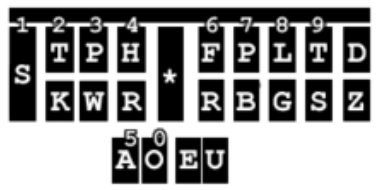 I don’t know what it is about people. They may talk smooth and slow while they’re carrying on a conversation, and then — WHAM! They hit a list of numbers and they’re rattling them off like it’s nobody’s business. Umm…hello, I’m trying to take it down over here!
I don’t know what it is about people. They may talk smooth and slow while they’re carrying on a conversation, and then — WHAM! They hit a list of numbers and they’re rattling them off like it’s nobody’s business. Umm…hello, I’m trying to take it down over here!
While I was reporting, numbers always made me nervous. Not because it was hard for me to hit the number bar, I was just anal about being accurate. If a plaintiff testified he incurred $595,998 in damages and I wrote $59,998, somebody’s gonna come after me. It’s one of the reasons why no matter how confident I was I had gotten every word in a depo or hearing, I would always carefully listen to the audio in that number section just to be sure I wrote it right.
Now that I’m captioning, it’s even more important I write it accurately and FAST. I tend to have weak pinkies, so my ones and nines usually end up translating as # because I don’t hit the number bar hard enough. And when numbers are flying by me so fast, a separate stroke for each number really brings down my speed.
Now that it’s summertime, the weather has been particularly challenging when it comes to being accurate and fast. Most of the country has been experiencing 90 plus degree heat. Forecasters whip out temps pretty quickly. Because of my weak pinkie, it’s not unusual for my ninety plus temps to come up #6, #4, etc.
Last week, the subject of weather and numbers and an easy way to handle it came up in a Facebook group I belong to. One captioner shared an amazing number trick that has just blown me away. I wish I had learned this it school, because it would have made my career so much easier when it comes to the number bar. I’m going to (hopefully) explain this well enough to make it understandable. If you were lucky enough to learn this in school, consider yourself blessed.
I think we can all agree that certain numbers are easy to write in one stroke because they’re in chronological order on the steno keyboard. Numbers like 24, 13, 48, 39, and 18 are a snap to write because you can write them all at once.
How to Write Numbers Easily on the Steno Machine
Numbers like 76, 92, 84, and 99 are harder to write (and less efficient) because it requires two strokes. We all know that more strokes equal less speed when it comes to steno writing. It also opens you up to potentially hitting the wrong number. (writing 92 when it should be 93)
My friend’s trick makes writing numbers quicker and more accurate by being able to write two numbers in one stroke by adding short i to the outline to reverse or double the numbers.
For instance, say you want to write 97. To write it all in one stroke, define 7 EU 9 as 97 in your dictionary. 81 would be written 1 EU 8. 44 would be 4EU.
Here’s an example to make it easy to add to your dictionary.
21 1EU2
22 2EU2
31 1EU3
32 2EU3
33 3EU
41 1EU4
42 2EU4
43 3EU4
44 4EU
51 1EU5
52 2EU5
53 3EU5
54 4EU5
55 5EU
60 0EU6
61 1EU6
62 2EU6
63 3EU6
64 4EU6
65 5EU6
66 EU6
70 0EU7
71 1EU7
72 2EU7
73 3EU7
74 4EU7
75 5EU7
76 6EU7
77 EU7
80 0EU8
81 1EU8
82 2EU8
83 3EU8
84 4EU8
85 5EU8
86 6EU8
87 7EU8
88 EU8
90 0EU9
91 1EU9
92 2EU9
93 3EU9
94 4EU9
95 5EU9
96 6EU9
97 7EU9
98 8EU9
99 EU9
I know it looks like a lot to add, but I was able to add them in about 10 minutes. I started out using this method when the weathermen was speaking at a normal pace. It only took me about a week for it to become automatic. Now I can’t imagine going back to the old way of doing numbers. I’ve gained so much speed now writing numbers.
If you find me clear as mud, leave me a comment and I’ll try to clarify it better. This is such a great way to handle numbers, you should definitely give it a shot to see if it will work for you.


So, how about longer numbers? Would you write 132 1/HUN/2EU3?
I’m trying to come up with a system to write three digit numbers, but haven’t had success. But if I were to write 132, I would write 1 on the number bar and then 2EU3. They should stitch together without you having to write the HUN.
Thanks, I’m on my last lesson of theory and the number bar is what we’re going over. I’m using your approach above since my instructor gave me the green light. I’m wavering over whether to stick with the number bar though, or use a numbering system and ditch the number bar altogether. Some say it’s more accurate. Easier to figure out a word that’s been misstroked, rather than a number. What do you think?
Hi there!
First off, congrats on reaching the end of theory!
I actually use both the bar and the write out method, it just depends on what number it is. Naturally, I write 1-10 out. But there are just some numbers that come up a lot and they’re easy to write out. That being said, when someone is rattling off six digit numbers really fast, I’ve found it faster to just use the number bar. What it comes down to, I think, is use whatever is comfortable for you, and it’s definitely not a “choose one over the other” situation. If you have any other questions, let me know 🙂
Thank you for putting this system for writing numbers out there! Really appreciate it since school was quite awhile ago and it wasn’t covered at that time in much detail….. Wondering if you have any tips or helpful hints for writing time, and dollars and cents. All I know is that for time you insert the colon. Is there a good way to define dollars and cents in your dictionary?
Hi! Sorry for the late reply. For time, I write the numbers, then I write KL-K. I have that defined to automatically put in the colon. For dollars, I write the numbers, then DL*F, which is defined to put a dollar sign in front. For dollars and cents, I write SDL*F, which will add the decimal and the dollar sign. Hopefully this makes sense 🙂
Do you have a system for writing 1900s years in one stroke?
No, I don’t have one yet. I need to come up with something though!